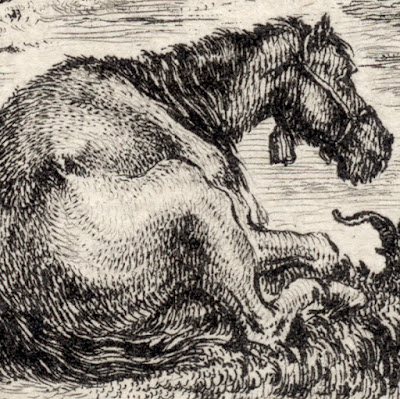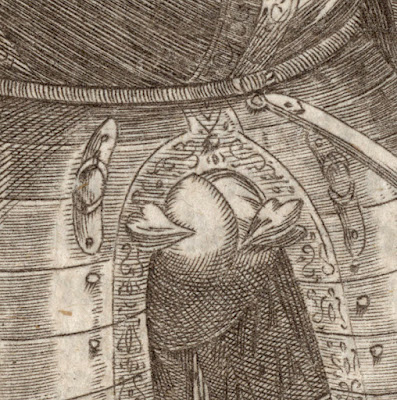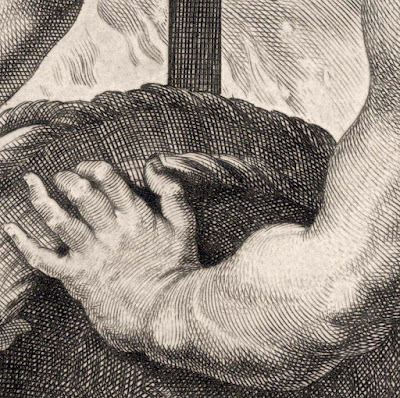Stefano della Bella (1610–64)
“Landscape with
animals”, c.1646, from the series of 13 plates, “Views of Roman ruins and
landscapes”, published by François
Langlois, il Ciartres (1588–1647)
Etching on fine
laid paper trimmed outside the image borderline and lined onto a sheet of heavy
wove paper (Dutch Etch).
Size: (sheet
diameter) 13.5 cm
De Vesme/Massar
1971 828.I (A.de Vesme, revised by Phyllis D.Massar 1971, “Stefano della Bella”,
New York)
The British
Museum offers the following description of this print:
“Landscape with
animals; a horse and two shepherds seated and a cow and two goats grazing, with
a waterfall behind to left; from a series of 13 round compositions. c.1646 Etching”
(http://www.britishmuseum.org/research/collection_online/collection_object_details.aspx?objectId=1502398&partId=1&searchText=della+bella&page=1)
The curator of
the BM offers the following information about the series of which this print is
a part, “Views of Roman ruins and landscapes”:
“Series of 13
round prints, all depicting views of Rome and the surrounding area, based on
drawings made on the spot, many of which were in two sketchbooks (now
dismantled) at the Uffizi. In the second state the plates are numbered; the
second state of the frontispiece also contains a dedication.” (http://www.britishmuseum.org/research/collection_online/collection_object_details.aspx?objectId=1502212&partId=1&searchText=X%2c5.136&page=1)
Condition:
faultless rich and crisp impression. The sheet has been trimmed with only the
“FL” visible from the publication details that would have been outside the
trimmed area: “"F.L.D.Ciartres exc. cum Privil. Regis Christ." The print has been mounted onto heavy wove paper that is of conservation
quality.
I am selling
this very beautiful small round etching by one of the most famous of the late
Renaissance/Mannerists for AU$215 in total (currently
US$165.11/EUR155.94/GBP132.72 at the time of posting this listing) including
postage and handling to anywhere in the world.
If you are
interested in purchasing this sensitively executed and skilfully composed
etching, please contact me (oz_jim@printsandprinciples.com) and I will send you
a PayPal invoice to make the payment easy.
This print has been sold
After reading
the British Museum’s curator’s advice that this and the other prints of the
same series (viz. “Views of Roman ruins and landscapes”) were “based on
drawings made on the spot” (see earlier reference) I changed my original
thoughts that this print was a romantic concoction steeped in an Arcadian past where
lounging classically dressed shepherds gaze out into space and their animals
enjoy each other’s company. Now that I am informed that there really is such a
place—even if it is only bits of it—I want to be there.
For me, this print is the work of a true master. For example, I am amazed that within an area equivalent in size to a postage stamp that della Bella is able to render the form of the foreground horse with such unambiguous clarity that I could even model it in clay. I am especially impressed with his subtle use of contour-marks that “explain” the curves of the horse’s right flank and his insightful control of the thickness and thinness (i.e. linear phrasing) of the flank's silhouette outline.
Almost as remarkable as the sensitive treatment of the scene is the composition
underpinning it. For instance, note how della Bella uses the meandering “S”-shaped
curve of the path leading from the centre foreground to invite the eye on a
visual journey to explore far into the distance. Even more interesting for me is that the round shape of the image is not perceived to
be a flat, but rather it seems three-dimensional like a sphere. What I mean by
this is that the artist has arranged the composition so that large forms are
towards the centre and smaller ones are at the outer circumference giving the
impression of optical distortion as if I were looking into a convex or a spherical
mirror.


























































